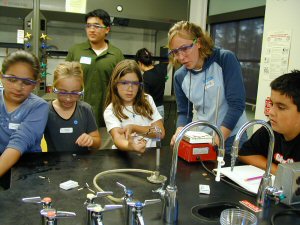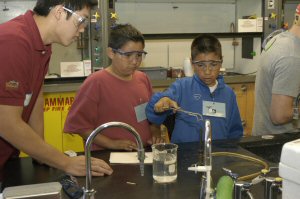Copper to "Silver" to "Gold"

1. The alchemist's dream. Talk about alchemy as you do the experiment.
2. Place very shiny pennies in hot 3M NaOH and powdered zinc solution (IN THE HOOD). A hot plate is used, keep solution near boiling temperature. Brand new shiny pennies work great.
Pennies remain in solution 3 to 5 minutes until pennies appear to be completely silver. Talk about the difference between pre-1982 and post-1982 pennies and how we make silver and gold pennies as follows.
Pre-1982 pennies contain a much greater percentage of copper. Post-1982 pennies are mostly zinc. Show the broken penny which is mostly zinc inside. Show them a copper, "silver" and "gold" penny. Talk about how the zinc atoms on top of the copper atoms make the pennies look silver. How do we make the "gold" pennies? We heat the pennies in the flame of a Bunsen burner. As we heat the silver penny the atoms move. The zinc atoms move in between the copper atoms. Help students visualize this be putting one of your hands on top of your other hand the show that if heat makes your fingers move it allows fingers from one hand to move in between the fingers of your other hand. Copper and zinc atoms make brass and looks like gold. Ask if anyone plays a saxophone or a trumpet? These are made of brass.
3. Remove "silver" pennies from solution using tongs and rinse them in water (use 600 mL beaker of water to cool pennies).
The pennies are zinc plated and appear silver in color. Small chunks of zinc are usually stuck on the penny. Students take a penny to the sink and in the tub of water they use their hands to remove all the zinc chunks, until the penny is totally clean.
SAFETY: Do NOT dry the pennies with paper towels. Small pieces of zinc on a paper towel can ignite and cause a fire in the lab.
4. Students take their penny to a Bunsen burner. They use tongs to pick up one penny at a time (the tongs are positioned on the edges of the penny). Adult supervision is required anytime a Bunsen burner is on.

Heat zinc plated copper pennies in the flame of a Bunsen burner. Turn the penny in the flame as it heats. The zinc and copper atoms form brass. The copper and zinc atoms merged to produce "gold" pennies.
SAFETY: Remove from heat immediately when yellow color appears and submerge the penny and tongs in the beaker of water located next to the Bunsen burner. This will cool the tongs and the penny so no one gets hurt.

